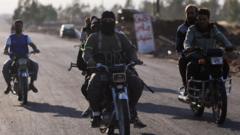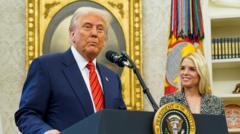Following intense missile strikes between Iran and Israel, Iran’s foreign minister confirmed a cease-fire hours after President Trump's announcement. However, uncertainty persists as Israel has yet to acknowledge the agreement, and both sides appear to continue military actions, complicating the potential for lasting peace.
Uncertain Cease-Fire: Iran Confirms Halt in Hostilities with Israel, but Confusion Reigns

Uncertain Cease-Fire: Iran Confirms Halt in Hostilities with Israel, but Confusion Reigns
Amid escalating tensions, Iran announces a cease-fire with Israel following a series of missile exchanges, while the Israeli government remains silent on the agreement.
---
Amid an escalating conflict, Iran's foreign minister confirmed a cease-fire with Israel early Tuesday, just hours after President Trump's announcement. The timeframe for the cessation followed more than a week of hostilities involving missile exchanges between the two nations. Although the cease-fire was pitched as a significant diplomatic breakthrough, confusion remains as the Israeli government has not responded to the announcement.
The cease-fire was reportedly negotiated with the help of Qatari officials, who mediated between the two adversaries. Iran’s foreign minister, Abbas Araghchi, indicated on social media that military operations had ceased at 4 a.m. local time. However, as this deadline approached, Israel continued its military strikes, suggesting the term “cease-fire” might be interpreted differently on both sides. This ambiguity was exemplified by ongoing missile launches, underscoring the fragile nature of the peace efforts.
The U.S. also played a pivotal role in these developments. Trump claimed that negotiations for the cease-fire emerged following American bombers' strikes on Iranian nuclear facilities, asserting that a “Complete and Total CEASEFIRE” was agreed upon. While such rhetoric aimed for optimistic sentiment, others within the political sphere remain cautious, highlighting that military activities persisted on both sides, leading to questions about the feasibility of the so-called ceasefire.
This ceasefire announcement and subsequent missile exchanges followed Iran's retaliatory strikes targeted at Al Udeid Air Base in Qatar, a critical military hub for American forces. The U.S. reported that of the missiles fired, a majority were intercepted without fatalities among American troops stationed there. Defaulting to historical patterns, Iran appeared to limit damage with prior warnings, which resemble its previous calculated responses during heightened tensions.
With the situation remaining fluid, key global players including the European Union voiced concerns following urgent meetings. The EU underscored the necessity for diplomatic measures to address the hostilities, urging both Iran and Israel to seek de-escalation to avoid further violence in the region.
As this conflict treads on uncertain ground, it remains to be seen whether peace talks can lead to an actual cessation of hostilities or if military operations will ramp up once again. The international community watches closely for any sign of sustained peace as tensions in the region weigh heavy on global economic and security concerns.
Amid an escalating conflict, Iran's foreign minister confirmed a cease-fire with Israel early Tuesday, just hours after President Trump's announcement. The timeframe for the cessation followed more than a week of hostilities involving missile exchanges between the two nations. Although the cease-fire was pitched as a significant diplomatic breakthrough, confusion remains as the Israeli government has not responded to the announcement.
The cease-fire was reportedly negotiated with the help of Qatari officials, who mediated between the two adversaries. Iran’s foreign minister, Abbas Araghchi, indicated on social media that military operations had ceased at 4 a.m. local time. However, as this deadline approached, Israel continued its military strikes, suggesting the term “cease-fire” might be interpreted differently on both sides. This ambiguity was exemplified by ongoing missile launches, underscoring the fragile nature of the peace efforts.
The U.S. also played a pivotal role in these developments. Trump claimed that negotiations for the cease-fire emerged following American bombers' strikes on Iranian nuclear facilities, asserting that a “Complete and Total CEASEFIRE” was agreed upon. While such rhetoric aimed for optimistic sentiment, others within the political sphere remain cautious, highlighting that military activities persisted on both sides, leading to questions about the feasibility of the so-called ceasefire.
This ceasefire announcement and subsequent missile exchanges followed Iran's retaliatory strikes targeted at Al Udeid Air Base in Qatar, a critical military hub for American forces. The U.S. reported that of the missiles fired, a majority were intercepted without fatalities among American troops stationed there. Defaulting to historical patterns, Iran appeared to limit damage with prior warnings, which resemble its previous calculated responses during heightened tensions.
With the situation remaining fluid, key global players including the European Union voiced concerns following urgent meetings. The EU underscored the necessity for diplomatic measures to address the hostilities, urging both Iran and Israel to seek de-escalation to avoid further violence in the region.
As this conflict treads on uncertain ground, it remains to be seen whether peace talks can lead to an actual cessation of hostilities or if military operations will ramp up once again. The international community watches closely for any sign of sustained peace as tensions in the region weigh heavy on global economic and security concerns.






















